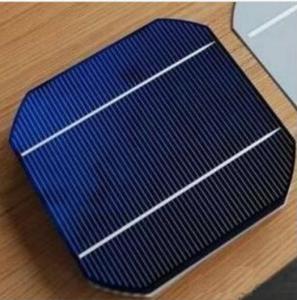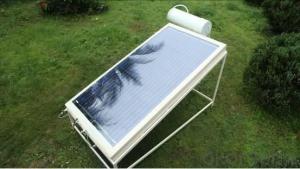Monocrystalline Solar Cell for Solar PV Panel
- Loading Port:
- China main port
- Payment Terms:
- TT or LC
- Min Order Qty:
- 10000 watt
- Supply Capability:
- 10000000 watt/month
OKorder Service Pledge
OKorder Financial Service
You Might Also Like
1. Structure of Monocrystalline Solar Cell for Solar PV Panel Description
A solar cell, or photovoltaic cell, is an electrical device that converts the energy of light directly into electricity by the photovoltaic effect,
which is a physical and chemical phenomenon. It is a form of photoelectric cell, defined as a device whose electrical characteristics, such
as current, voltage, or resistance, vary when exposed to light. Solar cells are the building blocks of photovoltaic modules, otherwise known
as solar panels.
2. Main Features of the Monocrystalline Solar Cell for Solar PV Panel
• High module conversion efficiency, through superior manufacturing technology
• 0 to +5W positive tolerance for mainstream products
• Certified to withstand high wind loads and snow loads
• Anodized aluminum is mainly for improving corrosion resistance
• Anti-reflective, Highly transparent, low iron tempered glass
• Excellent performance under low light environment
3. Monocrystalline Solar Cell for Solar PV Panel Images
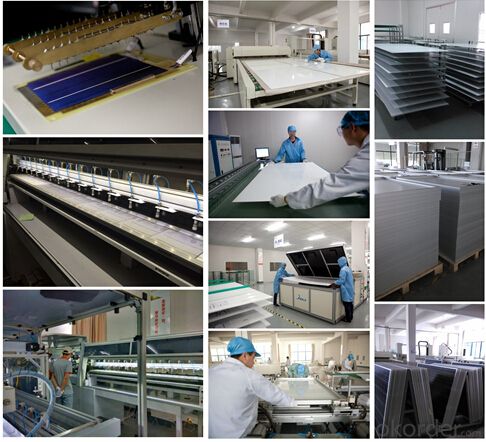
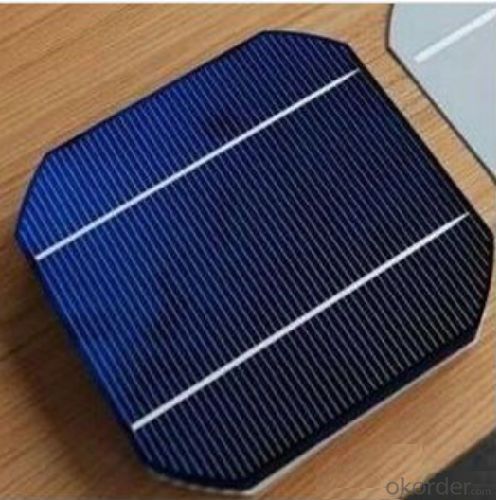
4. Monocrystalline Solar Cell for Solar PV Panel Specification
窗体顶端 Solar Cell 窗体底端 | Mono-crystalline silicon 125 × 125 mm ( 5 inches ) |
No. of Cells | 72 (6× 12) |
Dimensions | 1580 × 808 × 35mm |
Weight | 15.5 kgs |
Front | Glass 3.2 mm tempered glass |
Frame | Anodized aluminium alloy |
Junction Box | IP67 / IP65 rated (3 bypass diodes) |
Output Cables | TUV (2Pfg1169:2007), UL 4703, UL4703 ,4.0 mm2, symmetrical lengths |
(-) 900mm and (+) 900 mm | |
Connectors | MC4 compatible |
Mechanical load test | 5400Pa |
Resistance | 277g steel ball falls down from 1m height and 60m/s wind |
窗体顶端 Temperature Characteristics 窗体底端 | |
Nominal Operating Cell Temperature (NOCT) | 45±2°C |
Temperature Coefficient of Pmax | -0.44 %/°C |
Temperature Coefficient of Voc | -0.33 %/°C |
Temperature Coefficient of Isc | 0.055 %/°C |
5. FAQ of Monocrystalline Solar Cell for Solar PV Panel
Q1. How long can we receive the product after purchase?
A1.In the purchase of product within three working days, We will arrange the factory delivery as soon as possible. The pecific time of
receiving is related to the state and position of customers
Q2. Can we visit your factory?
A2:Surely, I will arrange the trip basing on your business schedule.
Q3:Which payment terms can you accept?
A3:T/T,L/C,Moneygram,Paypal are available for us.
Basic procedure of the working about solar cells
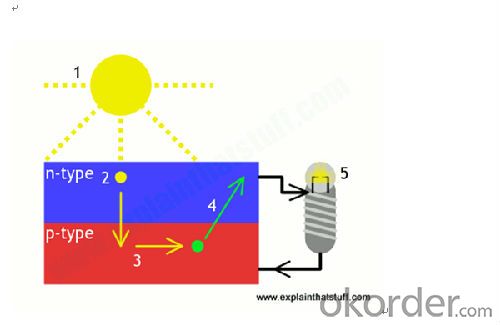
A solar cell is a sandwich of n-type silicon (blue) and p-type silicon (red). It generates electricity by using sunlight to make electrons hop across the junction between the different flavors of silicon:
When sunlight shines on the cell, photons (light particles) bombard the upper surface.
The photons (yellow blobs) carry their energy down through the cell.
The photons give up their energy to electrons (green blobs) in the lower, p-type layer.
The electrons use this energy to jump across the barrier into the upper, n-type layer and escape out into the circuit.
Flowing around the circuit, the electrons make the lamp light up.
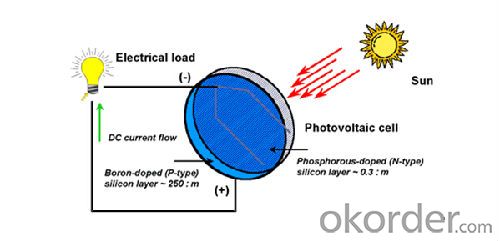
Working of PV cells
A typical silicon PV cell is composed of a thin wafer consisting of an ultra-thin layer of phosphorus-doped (N-type) silicon on top of a thicker layer of boron-doped (P-type) silicon. An electrical field is created near the top surface of the cell where these two materials are in contact, called the P-N junction. When sunlight strikes the surface of a PV cell, this electrical field provides momentum and direction to light-stimulated electrons, resulting in a flow of current when the solar cell is connected to an electrical load
- Q:Can solar cells be used on rooftops?
- Yes, solar cells can be used on rooftops. In fact, rooftop solar panels are one of the most common and effective ways to harness solar energy for residential and commercial purposes. They are installed on the rooftops of buildings to convert sunlight into electricity, providing a sustainable and cost-effective source of power.
- Q:How can I calculate the cost of using solar cells if I put a fully-functional solar system in my house?
- On average the total cost of solar installation can be between $15,000 to $29,000 for systems sized between 4kW and 8kW.2
- Q:Is silicon-based solar cells and silicon-based thin-film solar cells the same?
- General silicon-based solar cells refer to monocrystalline silicon and polycrystalline silicon solar cells, while silicon-based thin-film solar cells are similar to sunpower producing that type of battery that can be made into curved components.
- Q:How are solar cells integrated into building designs?
- Solar cells can be integrated into building designs in a variety of ways. They can be incorporated into the roof or facade of a building, where they function as both a renewable energy source and a structural element. Additionally, solar cells can be installed as shading devices, such as solar awnings or sunshades. This integration allows buildings to generate electricity from the sun while maintaining an aesthetically pleasing design.
- Q:Can solar cells be used to charge batteries?
- Yes, solar cells can definitely be used to charge batteries. Solar cells convert sunlight into electricity, which can be used to charge batteries for various applications such as powering small devices or storing energy for later use.
- Q:How do solar cells perform in regions with high levels of salt spray and corrosive environments?
- Solar cells generally do not perform well in regions with high levels of salt spray and corrosive environments. The salt particles can accumulate on the surface of the solar cells, leading to reduced efficiency and decreased performance. Additionally, the corrosive nature of the environment can cause damage to the materials and components of the solar cells, further impacting their functionality. To mitigate these issues, special protective coatings or materials can be used to enhance the durability and resistance of solar cells in such regions.
- Q:Can solar cells be used for aerospace applications?
- Yes, solar cells can be used for aerospace applications. They are commonly used in spacecraft and satellites to harness solar energy and provide power for various systems and instruments. Solar cells are lightweight, compact, and highly efficient, making them ideal for aerospace applications where weight and space are crucial considerations.
- Q:Can solar cells be used to power security systems?
- Yes, solar cells can be used to power security systems. Solar cells convert sunlight into electricity, which can be stored in batteries or used directly to power security systems such as cameras, motion sensors, and alarms. This allows for a reliable and sustainable power source, especially in remote locations or areas with limited access to traditional electrical grids.
- Q:Can solar cells be used for powering concert venues?
- Yes, solar cells can be used for powering concert venues. Solar panels can be installed on the roof or surrounding areas of the venue to capture sunlight and convert it into electricity. This renewable energy source can help reduce the carbon footprint of the venue and provide a sustainable solution for powering concerts.
- Q:Can solar cells be used for powering remote research stations?
- Yes, solar cells can be used for powering remote research stations. Solar cells, also known as photovoltaic cells, convert sunlight into electricity, making them an ideal and sustainable power source for remote locations. Solar panels can be installed at the research station to capture sunlight and generate electricity, which can then be stored in batteries for use during periods of low sunlight or at night. This enables the research station to operate independently of traditional power grids, reducing reliance on fossil fuels and providing a clean and renewable energy solution.
1. Manufacturer Overview |
|
|---|---|
| Location | |
| Year Established | |
| Annual Output Value | |
| Main Markets | |
| Company Certifications | |
2. Manufacturer Certificates |
|
|---|---|
| a) Certification Name | |
| Range | |
| Reference | |
| Validity Period | |
3. Manufacturer Capability |
|
|---|---|
| a)Trade Capacity | |
| Nearest Port | |
| Export Percentage | |
| No.of Employees in Trade Department | |
| Language Spoken: | |
| b)Factory Information | |
| Factory Size: | |
| No. of Production Lines | |
| Contract Manufacturing | |
| Product Price Range | |
Send your message to us
Monocrystalline Solar Cell for Solar PV Panel
- Loading Port:
- China main port
- Payment Terms:
- TT or LC
- Min Order Qty:
- 10000 watt
- Supply Capability:
- 10000000 watt/month
OKorder Service Pledge
OKorder Financial Service
Similar products
New products
Hot products
Hot Searches
Related keywords
